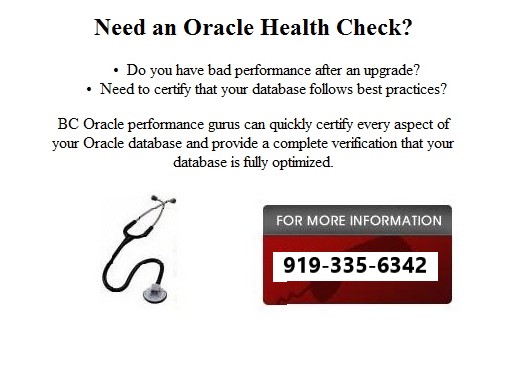This is an
excerpt from the book
Advanced PL/SQL: The Definitive Reference by Boobal Ganesan.
The XMLAGG function takes a list of
XML elements from one column and returns an aggregated XML
document in a single cell.
%
Note: XMLAGG
is an aggregate function.
|
The prototype of the XMLAGG function
is shown below,
XMLAGG(<XML_ELEMENT> ORDER BY
<VALUE>)
In the below listing, the XMLAGG
function aggregates the XML element of the first name of two
employees into a single cell XML data.
SELECT xmlagg(xmlforest(First_name)
order by first_name) XMLAGG
FROM employees
WHERE employee_id IN (100,101);
Result:
<FIRST_NAME>Neena</FIRST_NAME><FIRST_NAME>Steven</FIRST_NAME>
But this result misses an enclosing
parent tag to make it an XML document, which can be formed
wrapping this query with the XMLELEMENT function as shown
below,
SELECT xmlelement(Names,xmlagg(xmlforest(First_name)
order by first_name)) XMLAGG
FROM employees
WHERE employee_id IN (100,101);
Result:
<NAMES><FIRST_NAME>Neena</FIRST_NAME><FIRST_NAME>Steven</FIRST_NAME></NAMES>
Prior to the creation of the LISTAGG
function in the version 11gR2, XMLAGG was used for
aggregating the column values. The below statement imitates
the functioning of the LISTAGG function.
SELECT REPLACE(REPLACE(REPLACE(xmlagg(xmlforest(First_name)
ORDER BY first_name),'</FIRST_NAME><FIRST_NAME>',','),'<FIRST_NAME>'),'</FIRST_NAME>')
XMLAGG
FROM employees
WHERE employee_id IN (100,101);
Result:
Neena,Steven
In Oracle 9i and beyond we can use the
xmlagg function to aggregate multiple rows onto one
column:
select
deptno,
rtrim (xmlagg (xmlelement (e, ename
|| ',')).extract ('//text()'), ',') enames
from
emp
group by
deptno
;
DEPTNO ENAMES
---------- ----------------------------------------
10 CLARK,MILLER,KING
20
SMITH,FORD,ADAMS,SCOTT,JONES
30
ALLEN,JAMES,TURNER,BLAKE,MARTIN,WARD
XMLAGG
is used to aggregate multiple rows in a single XML document:
SELECT
XMLELEMENT
(
EMP,
XMLAGG
(
XMLELEMENT
(
DEPT,
XMLATTRIBUTES(DEPTNO),
XMLAGG
(
XMLELEMENT
(
NAME,
ENAME
)
ORDER BY
ENAME
)
)
ORDER BY
DEPTNO
)
)
FROM
EMP
GROUP BY
DEPTNO;
EMP
----------------------------
<EMP>
<DEPT DEPTNO="10">
<NAME>CLARK</NAME>
<NAME>KING</NAME>
<NAME>MILLER</NAME>
</DEPT>
<DEPT DEPTNO="20">
<NAME>ADAMS</NAME>
<NAME>FORD</NAME>
<NAME>JONES</NAME>
<NAME>SCOTT</NAME>
<NAME>SMITH</NAME>
</DEPT>
<DEPT DEPTNO="30">
<NAME>ALLEN</NAME>
<NAME>BLAKE</NAME>
<NAME>JAMES</NAME>
<NAME>MARTIN</NAME>
<NAME>TURNER</NAME>
<NAME>WARD</NAME>
</DEPT>
</EMP>
The inner XMLAGG function aggregates the
employees in each department and the outer XMLAGG aggregates
the department in the whole table. The result is a well
structured document that displays all the employees.
 |
Need to learn to program with PL/SQL?
For complete notes on programming in PL/SQL, we
recommend the book
Advanced PL/SQL: The Definitive Reference by Boobal Ganesan.
This is a complete book on PL/SQL with
everything you need to know to write efficient and
complex PL/SQL code. |
|
|
|
|
|
Oracle Training from Don Burleson
The best on site
"Oracle
training classes" are just a phone call away! You can get personalized Oracle training by Donald Burleson, right at your shop!

|
|
|

|
| |
|
Burleson is the American Team

Note:
This Oracle
documentation was created as a support and Oracle training reference for use by our
DBA performance tuning consulting professionals.
Feel free to ask questions on our
Oracle forum.
Verify
experience!
Anyone
considering using the services of an Oracle support expert should
independently investigate their credentials and experience, and not rely on
advertisements and self-proclaimed expertise. All legitimate Oracle experts
publish
their Oracle
qualifications.
Errata?
Oracle technology is changing and we
strive to update our BC Oracle support information. If you find an error
or have a suggestion for improving our content, we would appreciate your
feedback. Just
e-mail:
 and include the URL for the page. and include the URL for the page.


Copyright © 1996 - 2020
All rights reserved by
Burleson
Oracle ®
is the registered trademark of Oracle Corporation.
|
|
